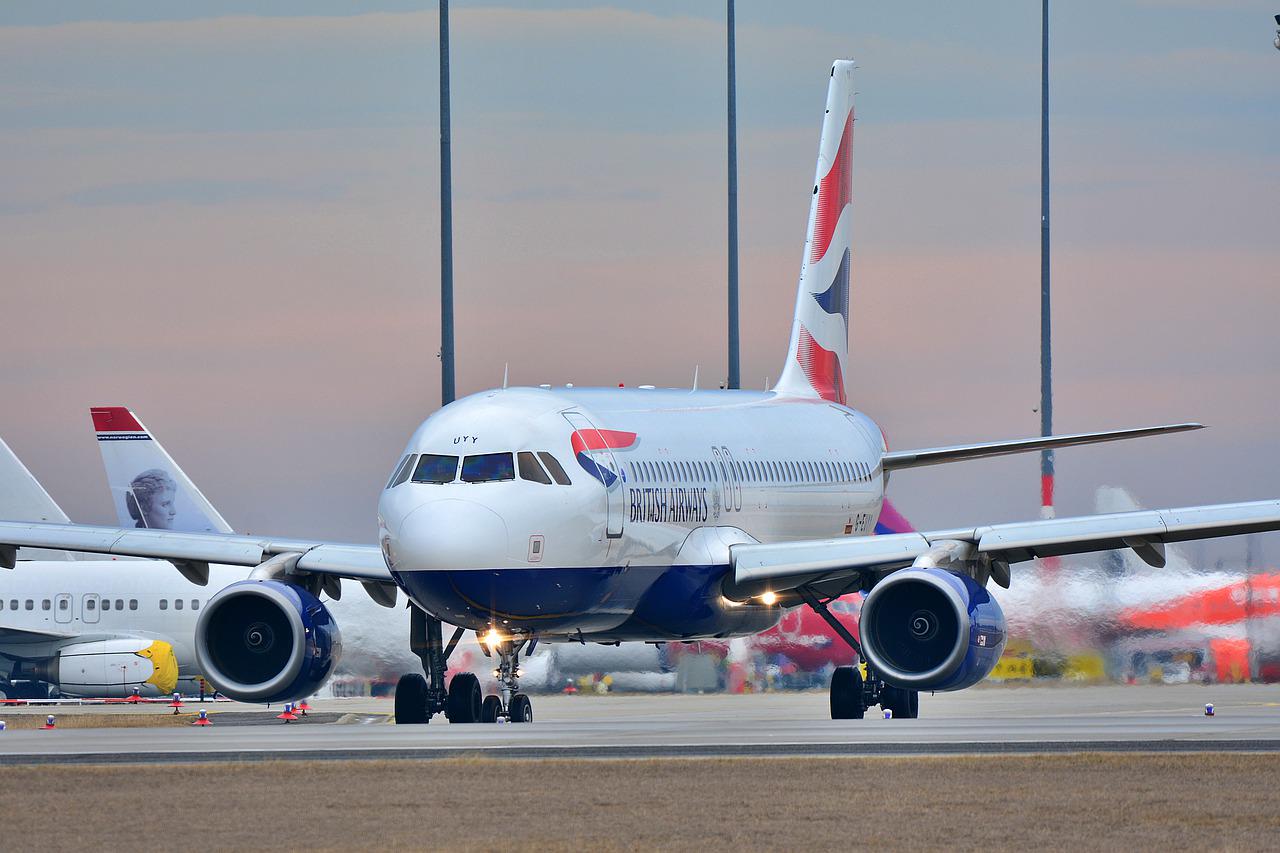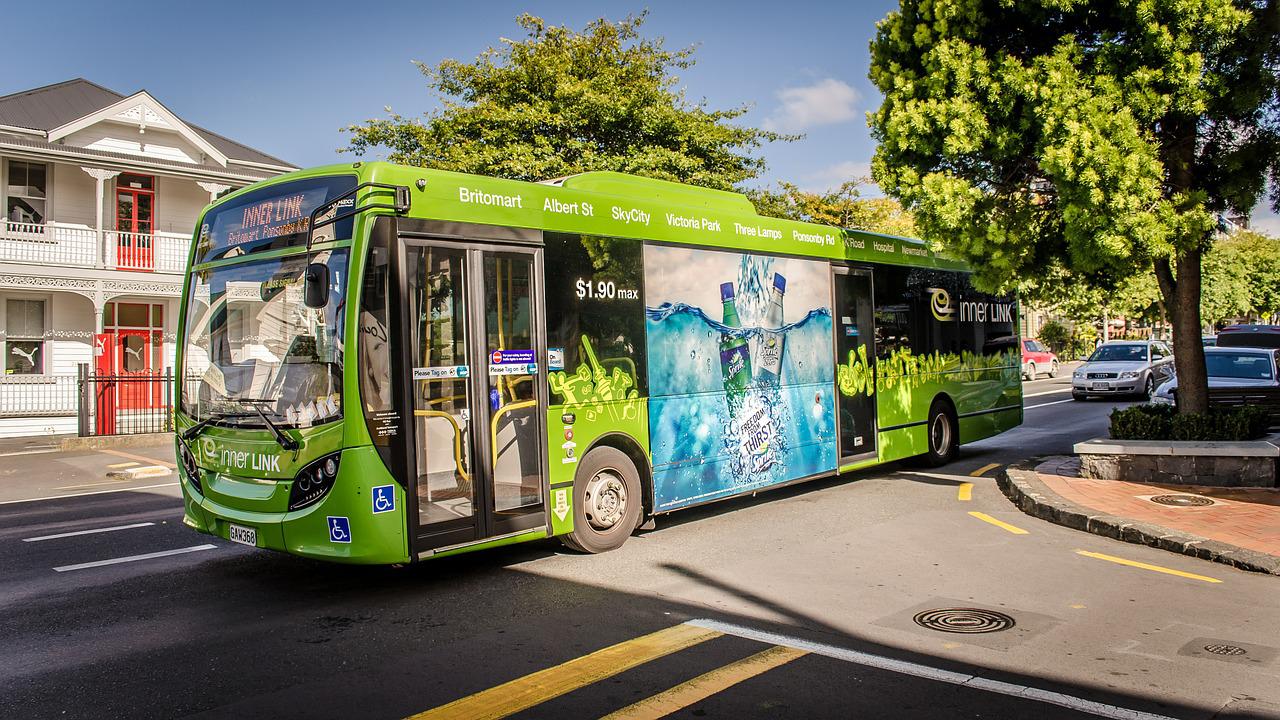Did you know that the hospitality industry is a multi-billion-dollar industry and one of the largest employers globally? This industry is a broad category of fields within the service industry that depends on the availability of disposable income, leisure time, and customer satisfaction. These fields include travel, tourism, lodging, event planning, food service, theme parks, etc. Hotels, tourism agencies, restaurants, and bars are the most important players in this industry. Moreover, the hospitality industry is one of the most profitable industries in many countries. For example, The travel industry in the United States generates more than $1 trillion each year. However, the hospitality industry faces many challenges that prevent it from reaching its maximum revenue generation potential. In this article, first, we will briefly review the hospitality industry. Then, we will discuss how Decision Optimization and Operations Research can resolve many of the challenges in this industry.
1. Overview of the Hospitality Industry
Pricing, occupancy, and demand represent key factors in determining hotel revenue, especially in the short term. Revenue management in the hospitality industry aims to find optimal inventory (e.g., rooms, resources) allocation and scheduling strategies and price setting to maximize revenue within the planning horizon. Short-term revenue management depends on (1) the possibility of advance bookings, (2) the ability to manage price variations across the booking horizon, and (3) the possibility of segmenting demand into homogeneous groups with different price elasticities; while medium and long-run revenue management depends on physical aspects, strategic factors or knowledge about demand behavior.
The following figure represents the sources of price variability (within the same hotel or among hotels) and demand (customer) segmentation:
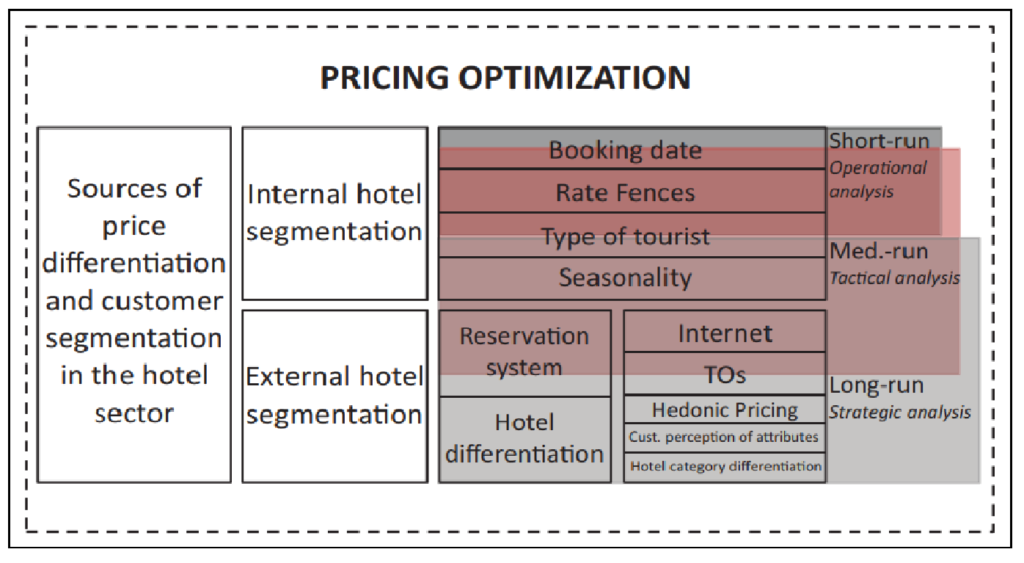
These sources can be divided into two categories:
1) internal hotel segmentation directly controlled and managed by the revenue management department; 2) external hotel segmentation, which this department cannot control. In brief, the sources in the internal hotel segmentation are booking dates, rate fences, types of tourists, and seasonality. On the other hand, the sources in the external hotel segmentation are reservation systems and hotel differentiation. A brief explanation of these sources are as follows:
- Booking dates: Hotels can set different room prices according to tourist booking behavior. The hotel can limit the number of rooms on sale to keep them back for later moments with more profitable demand at some points across the booking horizon.
- Rate fences: Rate fences represent the rules used to segment demand and justify differential pricing (e.g., refundability on advance reservations, minimum length of stay, group size, room type, etc.)
- Tourist types: Hotels distinguish between leisure and business travel because the business segment is generally more inelastic and can afford to pay higher prices.
- Seasonality: The weather, school holidays, religious festivals, and other special events can lead to high fluctuations in demand and prices.
- Reservation systems: Hotels use a diversity of reservation systems, including direct hotel sales or travel agencies.
- Traditional intermediaries: The role of leading tour operators (TOs) is to bridge tourism supply and demand and to market these packages to different tourist segments.
- The Internet: Travel agencies have been replaced by the Internet as a primary source for tourist information, which has had an enormous effect on hotel sector pricing strategies.
- Hotel differentiation: Hotels have different attributes and categories.
- Hedonic pricing: The value of hotel attributes and their characteristics is unobservable since they are not individually sold, so hedonic pricing models try to capture hotel price heterogeneity.
- Consumer hotel valuation: It is fundamental to understand customer assessments of hotel attributes since they affect customer satisfaction and behavior.
- Segmentation by hotel categories: Destination heterogeneity makes the agglomeration factor more attractive by reducing consumer search costs. A location close to competitors can assist in the generation of positive externalities in terms of the economic and institutional context. Higher levels of differentiation in a competitive cluster hurt low-cost hotels and positively impact luxury and high-priced ones since their characteristics boost the area’s attractiveness.
2. Challenges
Considering the short overview of the hospitality industry in Section 1, the most critical challenges of this industry are:
- The optimal pricing is complex as the hotel has to manage several issues, such as supply availability, customer valuation of the product, and expected future demand.
- Segmentation in tourism is challenging as every location may have different features, external factors, and past marketing efforts. Segmentation is the process where customers are grouped according to the needs and demand requirements they share. All of these customer groups share similar responses to price and marketing variables. The objective is to know who these customers are, how they buy, what they value, and their willingness to pay.
3) Occupancy and demand management play a crucial role in determining the hotels’ revenue due to certain hospitality industry features, including perishability, capacity limitations, and seasonality. But high demand variability and uncertainty of future demand and the presence of competitors and substitute products make pricing decision-making and demand management very challenging.
4) Detailed and accurate forecasts are crucial to revenue management in the hospitality industry. Inaccurate predictions lead to suboptimal decisions about the rate and availability recommendations produced by the revenue management system, which in turn negatively affects hotel revenue.
5) Tour route planning is a time-consuming task, and it is not easy to find out the attractions worth visiting and figure out the tour’s schedules. Traditional tourism cannot meet the needs of today’s tourists due to their varied preferences and time and budget limitations.
6) The travel destinations of rural leisure tourism are usually individual tourism operation spots in a village. Most areas have similar resources, but they scatter in a relatively large and distributed region rather than traditional scenic areas. Therefore, almost every weekend or holiday, most tourists are gathered in a few hot spots. However, very few tourists are attracted to other areas, usually not far from the hot spots and have similar tourism resources. For the unbalanced distribution of tourists, the tourism resources in the gathering areas may be consumed excessively, resulting in a severe decrease in tourist experience in these areas. In other areas where tourists are scarce, the tourism operating efficiency is low. So, this problem must be seriously considered to improve overall regional tourism profit and efficiency. However, it is quite a challenge to design a reasonable dispatching scheme to solve the problem. For the tourists, the scheme should provide the same or better travel experience after the diverting. The scheme should guarantee that the operating profit loss is limited to an acceptable degree after dispatching the operators in hot spots. Therefore, this problem has become a major issue for regulating leisure tourism in a region to affect sustainable development.
3. How Optimization Can Help
Here are some examples of how we can help hospitality companies operate more efficiently using Optimization, and data analytics, techniques:
- We can develop price optimization tools to maximize hotel revenue based on inventory scarcity, customer segmentation, and pricing. We can consider both explicit and implicit price optimization. Implicit price optimization involves utilizing various service packages, including combinations of the room rate, arrival date, duration of stays, amenities, and advanced purchase restrictions to serve a single physical room type. The explicit price optimization involves dynamically changing the prices of service packages to maximize revenues over a short-term horizon, which sets the prices for subsequent implicit price optimization. Implicit price optimization results from dynamically making only specific service packages available for sale at a point in time, for instance, making only the higher-priced packages available for projected high-demand periods. Thus, price is effectively, but indirectly, manipulated. The process of price optimization in our tool can consist of the four following steps: (1) the market segmentation, (2) the calculation of price demand elasticity (Price elasticity of demand is a measure of the change in the quantity purchased of a product concerning a change in its price.), (3) optimization of the price level, and (4) the Optimization and determination of the rate of the specific reservation. The creation of the price in step 4 depends on several key factors: length of stay, occupancy, working days/weekends, time from reservation to service implementation, current competitive prices, other services offered, and other attributes (e.g., ongoing events).
2) Price optimization and dynamic pricing represent different concepts. The main difference is that dynamic pricing is a particular pricing strategy, while price optimization can use any pricing strategy to reach its goals. For example, retailers can dynamically alter their products’ prices using a dynamic pricing strategy to match their competitors’ prices dynamically. This strategy would imply changing prices very frequently but not necessarily being the best strategy possible. Price optimization techniques focus on finding the price that maximizes a defined cost function (e.g., the hotel’s margin), considering many different factors to suggest such price or price range for different scenarios.
Therefore, we can develop dynamic pricing models that frame the price in terms of carefully optimized premiums and discounts over the hotel’s time-varying or seasonal reference price. Optimal dynamic pricing provided by these models deals with tourist booking dates. The customers are willing to pay different amounts of money for the same service as the date of stay approaches, so setting a pricing policy to maximize revenue on the date of stay is the problem. These dynamic pricing models can maximize revenue by offering a price that reflects current demand and occupancy levels, so past booking curves and details are useful variables for these models. Moreover, our dynamic pricing models can also reflect different customer behaviors. Each behavior may undergo different changes as the date of stay approaches and customer perceptions.
3) We should develop demand forecasting models, which take past reservation records from the hotel database as inputs and forecast the future demand of the hotel rooms. Each reservation record contains all the parameters that portray a specific reservation, like arrival date, reservation date, length of stay, and room type. Then, the forecasted future demands (reservations) are passed with all their attributes to the optimization model as an input. The optimization model hence determines rates and allocations according to the forecasted demand. Indeed, the optimization model maximizes profitability given all available information about demand and supply for a period in the past. The following image shows the relationship between data sets, predictive models, and optimization models.
As accurate forecasting can also help hotels better staffing, purchasing, and budgeting decisions, we can consider developing different forecasting models, including historical booking models, advanced booking models, and combined models. Historical booking models only consider the final number of rooms or arrivals on a particular stay night. Advanced booking models only include the buildup of reservations over time for a specific night of stay. Combined models use either regression or a weighted average of historical data and advanced booking models to develop forecasts.
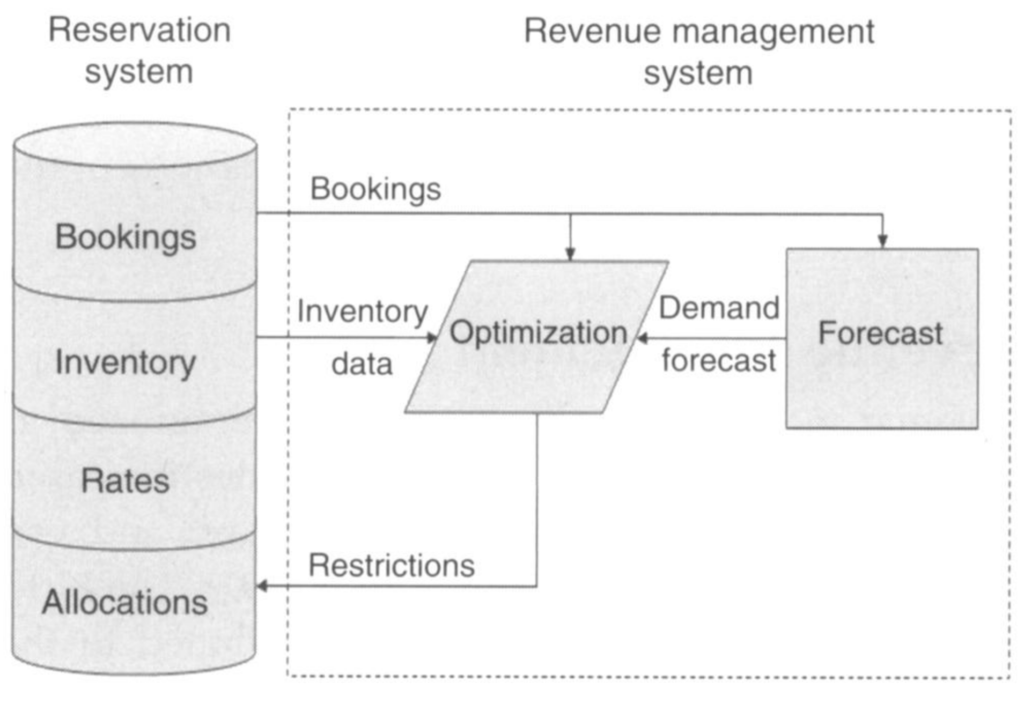
4) Tour route planning model is used to build high-quality tour routes for tourists. We can develop optimization models for tour route planning with the objective function of the tourism experience utility with a random utility framework. We can use a utility function for the tourism experience, consisting of tourism activities and travel utilities. These models maximize the random utilities of each alternative. Indeed, our models can maximize tourism experience utility considering tourists’ preference of attraction, time, and cost budgets. These models capture customer choice probabilities and measure their utility based on the use of historical data. They consider that individual demands are affected by different known attributes, and so their effects influence consumer choices. Since tourism experience has a significant impact on tourist satisfaction, tourists pay more attention to the tourism experience utility of the tour. Alternatively, we can consider the route planning problem as a network optimization problem and develop a stochastic programming model with uncertain demands where check-ins and check-outs can be viewed as the incoming and outgoing arcs of the nodes in the network. The following images depict a schematic view of such an optimization network.
5) For the problem mentioned in part 4, we can also develop optimization models and algorithms for rural leisure tourism passenger flow scheduling. These models maximize the overall tourist experience and operation profit of the whole region based on the protection of tourists’ travel experience and the interests of operators in the dispatching spots. The models can consider factors of all stakeholders in rural tourism to protect the interests of most tourists, operators, and the destination management organization.
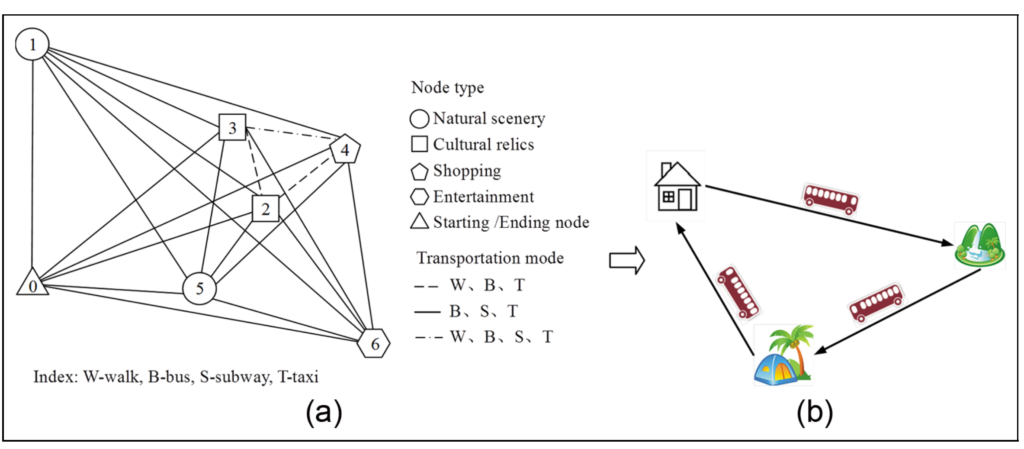
We can develop optimization tools for capacity planning. For example, we can focus on single resource capacity control problems that deal with optimally allocating a hotel room’s capacity for a given date at different rate classes. In another example, we can define the network control capacity problem, which is the problem of managing room capacity on consecutive days when customers stay multiple nights. This problem deals with a mix of customers having different lengths of stay and share the capacity on any given day. For these optimization tools, we can develop either rule-based heuristics or mathematical optimization models.




